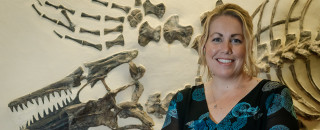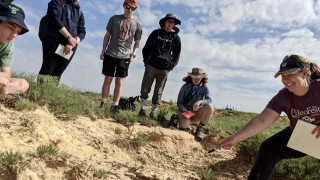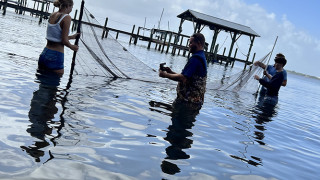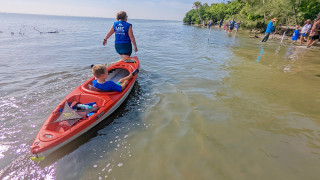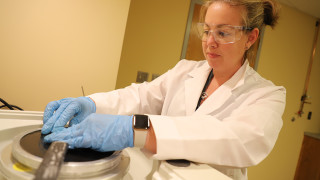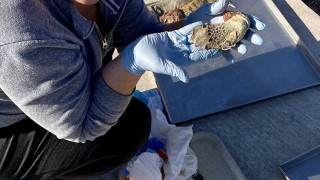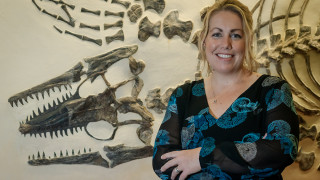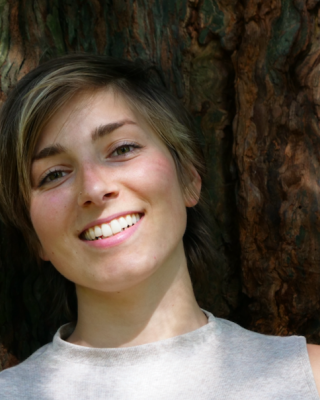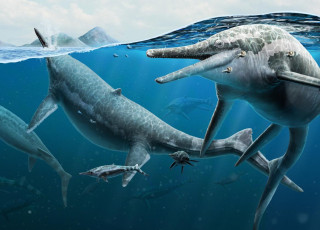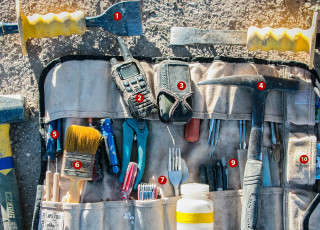DinoFest 2025 Keynote: Meet Laura Wilson, Ph.D.
This article is being published in advance of DinoFest, happening at NHMU on January 25 and 26, 2025, which will explore ancient underwater worlds and marine reptiles.
By Jude Coleman
While growing up in Atlanta, Laura Wilson, Ph.D., took trips every summer to Florida. In the mornings, she and her father hunted up and down the beach for shark teeth. Even at five years old, Wilson was smitten with the toothy treasures. “I didn’t understand that what we were finding were fossils, but I was so fascinated by sharks,” she said.
That fascination drew her to her first career aspiration of becoming a marine biologist who studied sharks. But as she learned more about the animals, she started to learn about their ancestors: ancient sharks like Megaladon. Around the same time, Jurassic Park premiered in theaters, and she took her first Earth science class in middle school, further inspiring her.
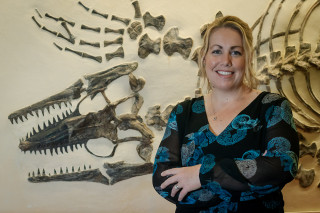
“I was one of those kids who loved paleontology and wanted to study dinosaurs,” Wilson said. Although she is now the Executive Director of the Marine Resource Council, a Florida-based non-profit centered on marine conservation, she’s worked as a paleoecologist for the last 25 years. Her work has focused on how ancient animals fit into their ecosystems, creating detailed snapshots of their lives and environments. Wilson is a keynote speaker at DinoFest this year, where she’ll be talking about her two main research areas: ancient seabirds and sea turtles.
Long before Wilson began those projects, she started getting hands-on paleontology experience as a volunteer on a dinosaur dig with the Museum of the Rockies in eastern Montana. Her small university in Virginia didn’t have a paleontology program, but spending her sophomore year summer digging was enough to seal her desire to pursue paleontology. So, she went to graduate school at Montana State University, where she studied the miniscule fossils of tiny vertebrate animals.
“That really got me interested in thinking big picture; animal-animal and animal-environment interactions,” Wilson said.
From Montana she went on to the University of Colorado. She studied an ancient seabird called Hesperornis for her PhD research, piecing together a picture of its life over 80 million years ago. Her work aimed to tease apart how the flightless birds lived their lives, interacted with other organisms, and with their environment. She describes them as goofy and charismatic, with long legs used for kicking in the water and tiny wings that were too small to support flight. After six years of studying Hesperornis’ ecosystem structure in Colorado, her research led her to Kansas, where their fossils are plentiful. “[I was] literally sitting on top of my research area, since fossils of these birds are still very actively found in the region.”
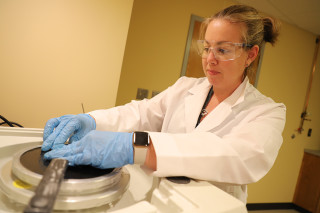
Grinding histology slides in the lab at the Sternberg Museum.
Hesperornis likely spent most of its life paddling on North America’s inland sea, which stretched from the Gulf of Mexico to the Arctic and split the continent’s land mass in half. The Late Cretaceous seabird does not have any living descendants but would have moved like cormorants and had a global distribution similar to penguins. That means Wilson could look for analogs between Hesperornis and living birds to help further understand the dinosaur. Yes, birds were — and still are — dinosaurs! Around 165 million years ago, an ancient ancestor of birds split off from small members of a group of two-legged dinosaurs called theropods. The descendants of those animals further split and diversified, evolving into birds like Hesperornis (around 100 million years ago) and eventually the feathered friends living on Earth today.
While in Kansas, Wilson worked as the Curator of Paleontology at the Sternberg Museum of Natural History in Hays. She also taught geology and paleontology courses at Fort Hays State University. As a professor, she worked with students on many animals of ancient ecosystems — like sharks, big marine reptiles, and sea birds — and how they all fit together. But a few years ago, she shifted gears.
“As so many stories start, things changed in 2020,” she said. While on sabbatical that fall, she turned to a sea turtle research project started years ago with her students. The project utilized osteohistology, a type of analysis where scientists look at the inside of bones of an animal to learn more about its life history. By cutting open sea turtle bones and looking at them under a microscope, Wilson could determine things like how fast the turtle grew and how long it lived. Her specimens lived around 85 million years ago, but just like with Hesperornith, she compared what she learned to research on their modern-day relatives.
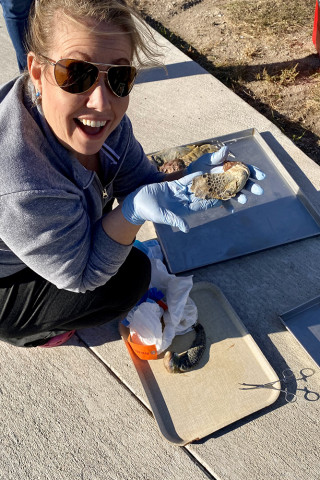
Processing green sea turtle flippers for future projects.
What started as a sabbatical project turned into a deeper interest as she learned more about the turtles. She realized she could use her paleoecology experience to bring what she’d learned about the sea turtles and apply it to conservation today. The knowledge gaps scientists have about modern sea turtles, such as aspects of their reproduction, are the same areas related to conservation strategies, she said. But she reasoned that the things she had discovered about ancient sea-turtles would be relevant to questions about their living relatives.
That revelation put her on the path to where she is today, working on conservation with the Marine Resource Council on the shores of Florida’s east coast. The organization’s goal is to protect and restore a 156-mile stretch of estuary called the Indian River Lagoon. The lagoon is very degraded due to decades of use from recreation, irresponsible land development, and commercial fishing, and the water quality has plummeted. Though her job isn’t exclusively research anymore, her day-to-day work is still variable, which she loves. Some days she’s booked with tasks that keep the gears of the non-profit turning; other days she’s wading through the lagoon, planting mangroves.
If there’s one thing Wilson has learned through her research, it’s that every layer of an ecosystem is important. She hopes her DinoFest presentation will remind people that all of those layers need to be considered in conservation. “We think about the big sexy apex predators…but there’s more than just that to these ecosystems, you have to have all these different levels that support them,” she said. “How can we take these lessons to learn how to protect what we have now so that it doesn't go extinct?”
1 of 6
